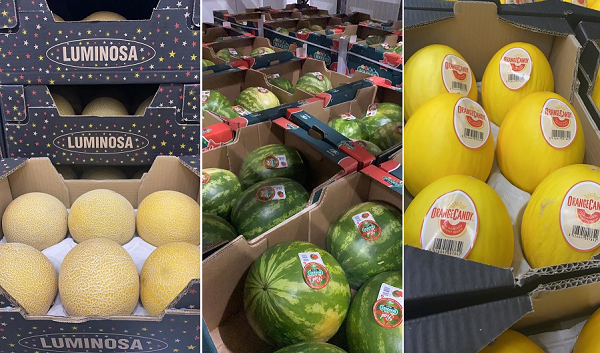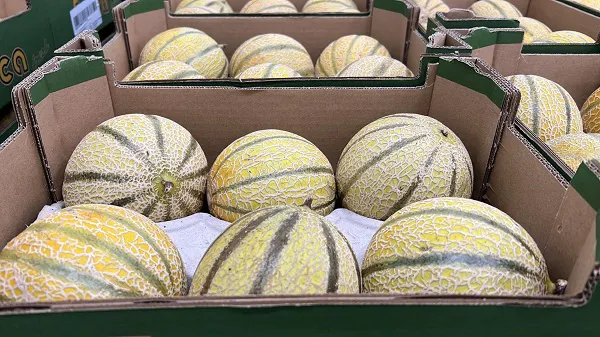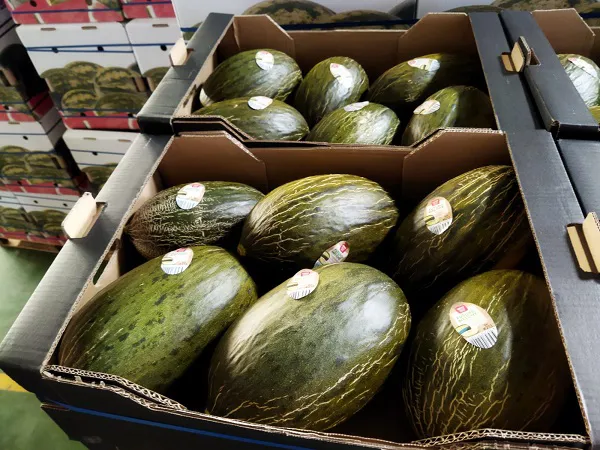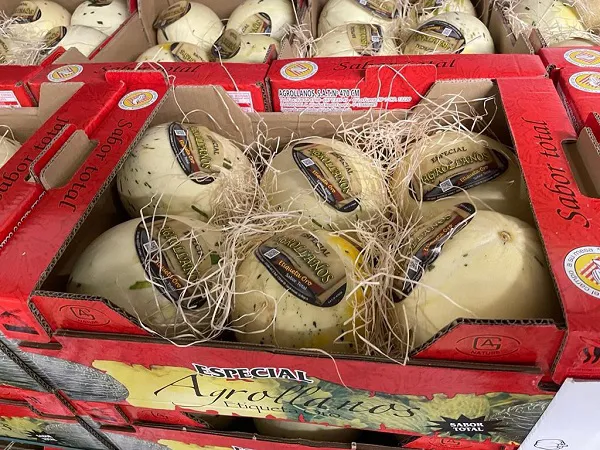"The melon season ended up being truly fantastic," begins Pieter de Ruiter, with no trace of doubt. He owns the Dutch company, 4 Fruit Company. Not that enormous amounts of fruit were sold - product availability was too limited for that, with acreage shrinking in Spain after the disastrous 2021 season. That shortage and the beautiful summer weather ensured great demand and more than satisfactory prices.

"Last year we began in May, with watermelons for €0.75/kg. By the end of May, that was already €0.40; in June and July, it was perhaps €0.10 more, but in August, it plummeted to €0.30. That was when I sometimes got calls, in the evening, from Spaniards, close to despair, begging me to load a few more melons. Occasionally I'd agree. I could pay €0.20 to €0.25 per kilo, which really didn't leave them anything. But we couldn't get rid of them in the Netherlands either. Last year was highly dramatic."
The weather as determining factor
This year the whole of Europe was unusually hot and sunny, which significantly boosted watermelon consumption. "Watermelon - and to a slightly lesser extent, melon - demand and pricing most closely follow the weather. If it gets above 20°C, supermarkets, smaller stores, and fruit stalls all want watermelon," Pieter knows. "This year, we started in May with €0.45, which quickly climbed to €0.80, even very briefly reaching €1.10. It dropped to €0.75 for a short time in June, and during a not-so-good week in July, even to €0.45. But then it rose again. In August, it flew up from €0.80 to €1 and on to €0.1.50. I had to call the Spaniards to ask for more products. But they didn't have any."
Shrinking area and sandstorm
According to the Spanish growers association, ASAJA, the acreage in the Almería province - where (water)melons are cultivated in greenhouses and harvested in May - decreased by ten percent. Growers opted for other crops after the dismal previous season. The rain and spring sandstorms did nothing to help, as poor fruit setting led to a further decline in the final harvest. All of Spain's cultivation regions' acreage shrank. "Starting in June, Murcia made product available, Alicante and Valencia joined in late June, and then, in full summer, it was Castilla-La Mancha's turn," Pieter lists. As in Almería, acreage declined by just over 10% in that region, too, as calculated by Castilla-La Mancha's Interprofessional Melon and Watermelon Organization.

Spain: world leader
Unsurprisingly, 4 Fruit Company gets its melons and watermelons from Spain, the world's largest watermelon exporter. With a share of more than a quarter of the global watermelon trade, it leaves Mexico and Italy, the numbers two and three, far in its wake. Faostat figures show that in 2020, with Spain's 21,620 hectares, of European countries, it had to beat only Ukraine's 46,500 hectares.
However, almost the entire Ukraine watermelon crop is destined for local consumption (33,878 tons of exports), while Spain concentrates on the export market (844.034 tons). Italy has about two-thirds of Spain's area (13,450 hectares) but does not achieve half of Spain's export volume (306,592 tons). Other exporting countries of some significance within Europe are Greece (8,770 hectares and 205,438 tons), France (1,010 hectares and 53,293 tons), and Hungary (3,740 hectares and 32,435 tons).
For melons, the picture is similar, with Spain's 18,520 hectares and 435,708 tons of exports taking the crown. France (13,110 hectares and 33,273 tons), Italy (23,760 hectares and 24,401 tons), and Greece (3,470 hectares and 7,824 tons) follow. Quite a bit of (water)melon is grown in southeastern Europe, for example, Romania with 17,980 hectares and Serbia with 5,237 hectares, but exports there are negligible.

Volume-wise, 4 Fruit Company marketed about half as much as last year. Not that the total volume in Spain was reduced to half; most of the major cooperatives and other suppliers' products are tied up in tight programs with major supermarket chains. So in a year with limited supply, the market supply inevitably suffers.
Good melon prices too
Although watermelons have the highest revenues, this year, melons fared well too. "Last season, Galias - we use this as an example because they're more popular than Cantaloupe and certainly Piel de Sapo in the Netherlands - started in May with a price of €3 for 4s, 5s, and 6s, but that soon dropped to €2.50. In June, the Murcia product fared a little better. Prices reached between €5 and €6 and even briefly reached €6.50. But it subsequently fell went to as low as €2.50. What a difference with this year: in May, those prices reached €5 at times; the average price in June too. Then in full summer, we reached a plateau of €7 on average, with as high as €8 for a brief time," explains Pieter.
Even though a caveat immediately accompanied them, these prices brought some relief to Spanish growers too. "If production costs and yields were those of previous summers, we'd be talking about a spectacular year. Given the circumstances, it's regarded as a good season," says Julián Díaz, president of the Alimer cooperative in Spain.
Focus on shelf life
Regarding Galias, Pieter laments that these days, primarily due to pressure from large markets like Germany and, particularly, the United Kingdom, shelf life is king. "Varietal breeding isn't stagnant, and with Galias, the emphasis is on shelf life. But that's sometimes slightly at flavor's expense. The major markets determine this development, and, rather unfortunately, we have to go along with that. Another important factor, of course, is average yield. Growers will obviously choose varieties that assure sufficient kilos. In Almería, for instance, the seed houses use this especially when advertising their varieties on roadside billboards. It's very bizarre to see: advertising like perfumes in a busy shopping district."
"It's theoretically possible for traders to bring older varieties back into their assortments. They just need to make a deal, at the right price, with a grower. But melon consumption is very weather-dependent, and in early spring, when the planting happens, you don't know what kind of summer it will be. So, traders are never sure if they'll manage to sell all their wares. Plus, you need volume. I have some good customers who'd certainly be up for this, but I wouldn't be able to get the quantities to convince the growers," says the trader.
Piel de Sapo last in line
At the time of writing, there was mainly Piel de Sapo in stores. "I find these look and taste best at this time of year. In May, it's not quite right yet. In June, when the first ones from Murcia come on the market, they're already of excellent quality. And now, with the supply from La Mancha, the product is truly delicious. In the Netherlands, however, people prefer very manageable melons and watermelons. Products like mini watermelons do very well, as do Galias. Cantaloupe, too, is popular, but Piel de Sapo doesn't sell until those two melon varieties are gone. And then it has to be 8s, 9s, or 10s, while people of Turkish descent prefer the large ones."

Yellow melons are even less popular in the Netherlands, adds Pieter. "These have the best shelf-life because their skin is the hardest. We export these mainly to the United Kingdom and Scandinavia. This year, we also had the Orange Candy, a melon that's yellow on the outside, and orange on the inside, like a Cantaloupe. They're crisp and very sweet. Some watermelon specialties, like the yellow and orange-fleshed ones, don't hit the mark. We struggle to sell a single palette a week. Fashion, with its smooth black peel, is a great product - nice and red inside and flavorful - but people still generally prefer striped watermelons."
"The melon season was fantastic, but there's the risk that these great prices will spur growers on to greatly expand their acreage next year. Couple that with a potentially mild summer, and it's an entirely different story again. I'm curious to see what will happen," Pieter concludes.
Pieter de Ruiter 4 Fruit Company
4 Fruit Company
Handelsweg 30
2988 DB Ridderkerk
+31 (0)180 641902
pr@4fc.nl
www.4fruitcompany.nl
